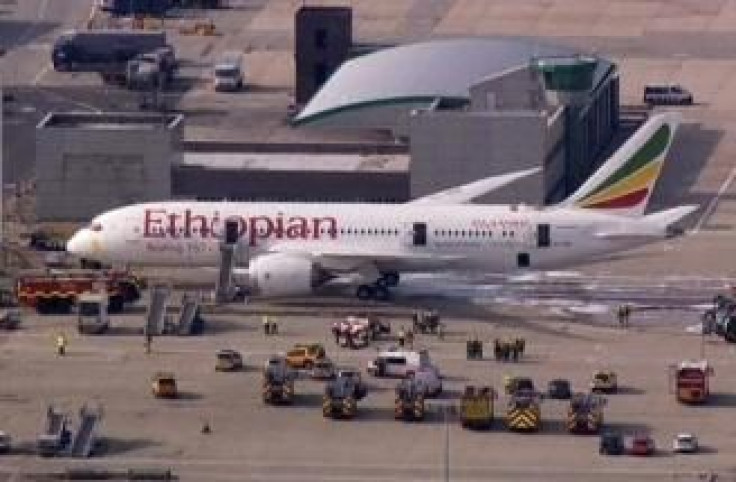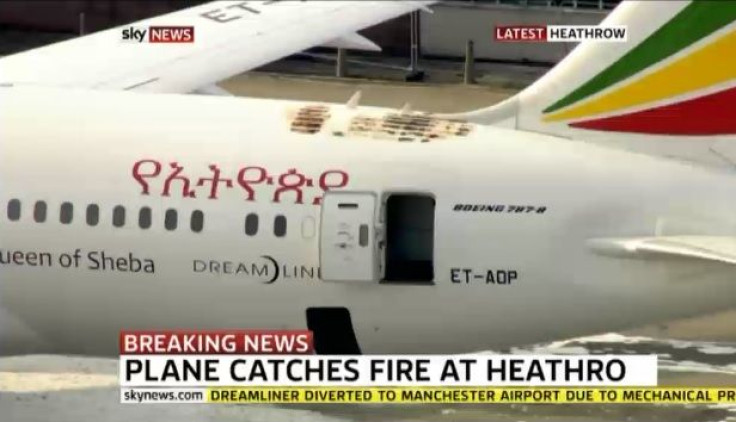Fire On Boeing 787 At Heathrow Raises Fear Of More Problems That May Ground Jet

UPDATE 4:30PM EDT -- Boeing Co. (NYSE:BA) shares closed up 0.13 percent for the day at $102 on Friday after dropping as much as 7 percent after a fire on a Boeing 787 Dreamliner at London's Heathrow airport raised fears that the company's newest jet would be grounded again.
The location of the fire damage, at the top of the rear part of the fuselage where the galley and crew rest area are located, dissipated fears that the fire was caused by the same battery problems that grounded all 787s worldwide in January.
The image below, adapted from the Boeing site, shows the location of the plane's batteries; the arrow indicates the location of the fire damage.

UPDATE 2:35 P.M. EDT -- An aviation analyst quoted by the Seattle Times, Scott Hamilton, of aviation intelligence company Leeham News, said the fire was unlikely to have been caused by a faulty battery. Batteries are located in the belly of the plane, where the cargo bays are located.
“What it doesn’t look like is that it’s a battery, and that’s the important part.” If it were a battery issue, “that would almost certainly put the plane back on the ground again,” Hamilton said.
A PDF file from Boeing shows where the flammable areas on a 787 are located. None are near the area that shows fire damage.
UPDATE 2.25 P.M. EDT -- Images from Sky News show that the fire has burned through the fuselage’s composite-materials skin. The area showing burn damages is located immediately in front of the vertical stabilizer. A seat map on the Ethiopian Airlines website shows that the aft part of the fuselage, immediately below the area damaged by fire, is occupied by a galley. It's still unknown whether a galley fire occurred. What is known is that the 787 was parked at a remote stand and that nobody was on board; the galley was therefore not being used for food preparation.
Boeing shares are paring their losses slightly, dropping by 4.2 percent to $102.39 on Wall Street.

In what could be a major blow to Boeing, a B787 passenger airplane caught fire on the tarmac at London’s Heathrow airport on Friday. The Ethiopian Airlines jet was parked and empty, and no one was injured, airport authorities said. The incident mirrors a fire on a Japan Airlines 787 at Boston’s Logan airport in January, when a battery caught fire. That event, plus an emergency landing in Japan, brought attention to fire risks associated with the plane’s innovative lithium ion batteries, which ultimately forced aviation authorities worldwide to ground all 787s while Boeing worked on a fix.
The 787s were grounded for three months until April and took to the air again when Boeing rolled out a solution. Ethiopian was the first 787 operator to resume flights.
The airport has been reopened to traffic after being temporarily closed while firefighters intervened.
Photographs on Twitter showed fire damage on the upper part of the rear fuselage, an area where no batteries are located. It's still unclear what may have caused the fire.
#Ethiopian Airlines Tail section damage on #Boeing 787 #Damage at #HeathrowAirport #AvGeeks #Dreamliners pic.twitter.com/IOXxhSJ2Rf
- Mo Firaas (@raisinganchor) July 12, 2013
Boeing Co. (NYSE:BA) shares dropped 5 percent on Wall Street at 1:30 p.m., about one hour after tweets about the accident began appearing.
Boeing said in a tweet that it was aware of the incident and sending personnel to Heathrow.
We’re aware of the 787 event @HeathrowAirport and have Boeing personnel there. We're working to fully understand and address this.
- Boeing Airplanes (@BoeingAirplanes) July 12, 2013
Also on Friday, another 787, belonging to UK-based leisure carrier Thomson Airways, returned to Manchester after taking off bound for Orlando, Fla., because of an unspecified issue. Thomson said in a statement quoted by the Associated Press that Flight 126 had returned to Manchester "as a precautionary measure." The airline said all passengers had disembarked from the plane and engineers are inspecting the aircraft.
Around 65 Boeing 787s fly with airlines around the world. The twinjet, the first to be made largely of composite materials, entered service in late 2011. More than 900 have been ordered.
© Copyright IBTimes 2024. All rights reserved.












